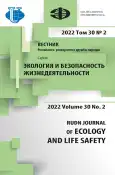Variability of body weight (Eremias arguta deserti Gmelin, 1789) and (Phrynocephalus guttatus guttatus Gmelin, 1789) in the southeastern part of the Lower Volga region
- Authors: Mishustin S.S.1, Polynova G.V.2
-
Affiliations:
- Armed forces infrastructure development directorate genera
- Peoples’ Friendship University of Russia
- Issue: Vol 30, No 2 (2022)
- Pages: 189-200
- Section: Biological resources
- URL: https://journal-vniispk.ru/2313-2310/article/view/324000
- DOI: https://doi.org/10.22363/2313-2310-2022-30-2-189-200
- ID: 324000
Cite item
Full Text
Abstract
One of the aspects of studies of micropopulations of ( Eremias arguta deserti Gmelin, 1789) and ( Phrynocephalus guttatus guttatus Gmelin, 1789) in the conditions of the southeastern part of the Lower Volga region was the observation of inter-seasonal fluctuations in body weight of individuals. Males of Eremias arguta deserti are consistently heavier in the spring than females. In the autumn periods, the results turned out to be contradictory and do not make it possible to conclude which individuals of which sex have the greatest mass. Statistical processing of materials using the Kruskal - Walli’s criterion (H) did not reveal significant differences in Eremias arguta deserti when comparing the mass of all females and males both for all periods and separately in spring and autumn periods. Phrynocephalus g. guttatus also showed no statistical significance when comparing all males and females for the entire period. However, the results obtained when comparing between females and males during the 2018 season, as well as when comparing females of different years, were statistically significant. In addition, the body weight of fingerlings of both groups, between the autumn seasons of 2017 and 2018, revealed statistical significance. Individuals of both Phrynocephalus g. guttatus and Eremias arguta deserti steadily gain body weight, despite the slowdown or complete stop of the growth of individuals in the former and autotomy in the latter. Regeneration of the tail or its absence obviously affects the growth of the trunk of Eremias arguta deserti.
About the authors
Stanislav S. Mishustin
Armed forces infrastructure development directorate genera
Email: s1kator@mail.ru
ORCID iD: 0000-0002-5812-6592
engineer for environmental protection
Moscow, RussiaGalina V. Polynova
Peoples’ Friendship University of Russia
Author for correspondence.
Email: polynova-gv@rudn.ru
ORCID iD: 0000-0003-0217-5771
PhD of Biological Science, Associate Professor, Department of Environmental Management, Institute of Environmental Engineering
6 MiklukhoMaklaya street, Moscow, Russian FederationReferences
- Mishustin SS, Polynova GV. The Impact of predation on the abundance of steppe runners, Eremias arguta deserti (Gmelin, 1789), in semi-deserts of the southeastern part of the Lower Volga region. Scientific Notes of Kazan University. Series: Natural Sciences. 2020;162(3):461—472. doi: 10.26907/2542-064X.2020.3.461-472. (In Russ.)
- Polynova GV, Mishustin SS. Changes in the spatial structure of the Eremias arguta deserti population in semi-deserts of the Astrakhan region. Principles of Ecology. 2020;(2):87‒96. (In Russ.)
- Shvarc SS, Gurvich ED, Ishchenko VG, Sosin VF. Functional unity of populations. Biology Bulletin Reviews. 1972;33(1):3—14. (In Russ.)
- Tinkle DW, Woodward DW. Relative movements of lizards in natural populations as determined from receptive radii. Ecology. 1967;48(1):166—168.
- Multicolored lizard. Monographs / ed. Shherbak NN. Kiev: Naukova dumka Publ. 1993. (In Russ.)
- Kotenko TI. Reptiles of the Left Bank Steppe of Ukraine: Dissertation of Candidate of Biological Sciences: 03.00.08. Kiev, 1983 (In Russ.)
- Brushko ZK. Lizards of desert regions of Kazakhstan. Almaty, Konzhyk Publ. 1995. (In Russ.)
- Cooper Jr, William E, Smith S. Costs, and economy of autotomy for tail movement and running speed in the skink Trachylepis maculilabris. Can. J. Zool. 2009;87:400—406.
- Dujsebayeva TN, Barabanov AB, Ananjeva NB. Lizards of the Kazakhstan: stages of study and actual taxonomy. Herpetological and ornithological research: current aspects Dedicated 10 the 100th Anniversary of Rustamov (1917—2005). Saint Petersburg. Moscow. КМК Scientific Press Publ. 2018.
- Sergeev AM. Materials after postembryonic growth of reptiles. Zoological Journal. 1939;28(5):888—903. (In Russ.)
Supplementary files









